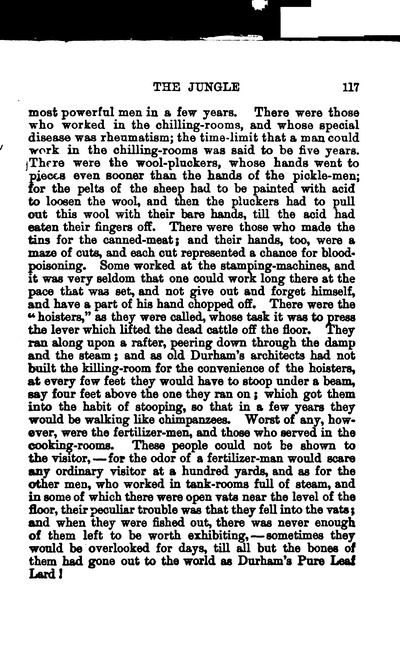 p116 _
-chap- _
toc-1 _
p117w _
toc-2 _
+chap+ _
p118
p116 _
-chap- _
toc-1 _
p117w _
toc-2 _
+chap+ _
p118
most powerful men in a few years. There were those
who worked in the chilling-rooms, and whose special
disease was rheumatism; the time-limit that a man could
work in the chilling-rooms was said to be five years.
There were the wool-pluckers, whose hands went to
pieces even sooner than the hands of the pickle-men;
for the pelts of the sheep had to be painted with acid
to loosen the wool, and then the pluckers had to pull
out this wool with their bare hands, till the acid had
eaten their fingers off. There were those who made the
tins for the canned-meat; and their hands, too, were a
maze of cuts, and each cut represented a chance for blood-
poisoning. Some worked at the stamping-machines, and
it was very seldom that one could work long there at the
pace that was set, and not give out and forget himself,
and have a part of his hand chopped off. There were the
"hoisters," as they were called, whose task it was to press
the lever which lifted the dead cattle off the floor. They
ran along upon a rafter, peering down through the damp
and the steam; and as old Durham's architects had not
built the killing-room for the convenience of the hoisters,
at every few feet they would have to stoop under a beam,
say four feet above the one they ran on; which got them
into the habit of stooping, so that in a few years they
would be walking like chimpanzees. Worst of any, how~
ever, were the fertilizer men, and those who served in the
cooking-rooms. These people could not be shown to
the visitor, -- for the odor of a fertilizer-man would scare
any ordinary visitor at a hundred yards, and as for the
other men, who worked in tank-rooms full of steam, and
in some of which there were open vats near the level of the
floor, their peculiar trouble was that they fell into the vats;
and when they were fished out, there was never enough
of them left to be worth exhibiting, -- sometimes they
would be overlooked for days, till all but the bones of
them had gone out to the world as Durham's Pure Leaf
Lard!
[[117]]
p116 _
-chap- _
toc-1 _
p117w _
toc-2 _
+chap+ _
p118